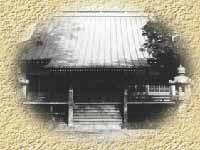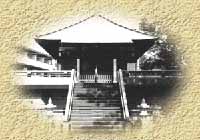The
origin of the Ensen-ji Temple dates back at least to the
late Nambokucho Period (Period of
the Northern and Southern Courts, 1332-1392)  when the Taishi-do Hall and
the Small Hall (Ensenbou the predecessor of Ensen-ji) are
considered to have already existed. The temple was then
restored by Great Master Kenkei in 1595. Its location is
in a corner of Musashino, the plain spreading in the west
of Tokyo, but the area around the temple has been a human
dwelling site from the Jyoumon (c. 8,000 to c. 300 BC)
and Yayoi (c. 300 BC to c. AD 300) Periods and nourished
an ingenuous culture with considerable productive power
in the feudal ages. This area came to play an important
role as a vegetables growing area for people in Edo (old
name of Tokyo) in the early 16th century. As the economy
of Taishido Village became gradually stable, the temple
precincts were enlarged and properly arranged with the
Taishi-do Hall and other additional buildings including
the Main Hall. when the Taishi-do Hall and
the Small Hall (Ensenbou the predecessor of Ensen-ji) are
considered to have already existed. The temple was then
restored by Great Master Kenkei in 1595. Its location is
in a corner of Musashino, the plain spreading in the west
of Tokyo, but the area around the temple has been a human
dwelling site from the Jyoumon (c. 8,000 to c. 300 BC)
and Yayoi (c. 300 BC to c. AD 300) Periods and nourished
an ingenuous culture with considerable productive power
in the feudal ages. This area came to play an important
role as a vegetables growing area for people in Edo (old
name of Tokyo) in the early 16th century. As the economy
of Taishido Village became gradually stable, the temple
precincts were enlarged and properly arranged with the
Taishi-do Hall and other additional buildings including
the Main Hall.
Koushin Kuyoutou or the
Memorial Towers for the Blue Warrior were erected in 1672. The Koushin
belief of the Edo Period is usually divided into three
stages: the first, the middle, and the late. The Memorial
Tower of Ensen-ji belongs to the first stage and
consequently is of great historical importance. This
means Ensen-ji was the center of Koushin belief in the
area in those days. The Kyouou Reform (1716-36), a reform movement
instituted by the eighth shogun Tokugawa Yoshimune,
naturally intensified the pressure on the farmers.  It was followed by the
"Kyouhou great famine" of 1732-33, which took a
heavy toll of lives through starvation. In such a
situation of utmost social unrest, Great Master Shumyou
by holding up the light of Buddhist teachings, strived to
save people and thereby contributed to the further
development of the temple. The relationship between the
temple and local people came to be further strengthened
around the Bunka and Bunsei
eras (1804-30) when Edo culture most
flourished, and thus the temple enjoyed wider support
among people. It was followed by the
"Kyouhou great famine" of 1732-33, which took a
heavy toll of lives through starvation. In such a
situation of utmost social unrest, Great Master Shumyou
by holding up the light of Buddhist teachings, strived to
save people and thereby contributed to the further
development of the temple. The relationship between the
temple and local people came to be further strengthened
around the Bunka and Bunsei
eras (1804-30) when Edo culture most
flourished, and thus the temple enjoyed wider support
among people.
Unfortunately,
however, the temple buildings were all destroyed by fire
in 1857. The Main Hall, Taishi-do Hall, and priests'
living quarters were reconstructed in 1860 by offerings
from its followers, but they were far from being
comparable to what they were in splendor. In the wake of
the Shintoism-Buddhism Separation Edict the anti-Buddhist
movement known as "Haibutsu
Kishaku"(exterminating Buddhas and abandoning the
scriptures) that began in the early Meiji Period
(1867-1912), the temple then had to go through hard times
of decline. With Great Master Eison's assumption of
office as head priest of the temple, the followers joined
forces in an all-out effort to protect the temple. The
temple fortunately escaped the ravages of air raids
during World War II and continued to preach the teachings
of Buddha even in  the postwar period
of social and spiritual disorder. Thanks to the offerings
and labor service of the parishioners, large repairs of
the Taishi-do Hall corridor were carried out in 1951 in
commemoration of the 1330th anniversary of Crown Prince
Shoutoku's death. Then the Main Hall was repaired on a
large scale and the graveyard was improved in 1964, and
the Taishi-do Hall roof was repaired in 1969. In the
Heisei era that began in 1989, a series of construction
and repair projects followed, which include the
construction of the Taishi Assembly Hall, the move to a
new site of the Taishi-do Hall, the construction of the
Taishi Assembly Hall Annex (1996), and the refurbishment
of the Main Hall (1996). Thus Ensen-ji has kept the Lamp
of the Dharma burning ever since its foundation and has
remained "a spiritual shelter" for its
parishioners. The temple is designated as No. 51 of the
Eighty-eight Holy Places of Tamagawa. the postwar period
of social and spiritual disorder. Thanks to the offerings
and labor service of the parishioners, large repairs of
the Taishi-do Hall corridor were carried out in 1951 in
commemoration of the 1330th anniversary of Crown Prince
Shoutoku's death. Then the Main Hall was repaired on a
large scale and the graveyard was improved in 1964, and
the Taishi-do Hall roof was repaired in 1969. In the
Heisei era that began in 1989, a series of construction
and repair projects followed, which include the
construction of the Taishi Assembly Hall, the move to a
new site of the Taishi-do Hall, the construction of the
Taishi Assembly Hall Annex (1996), and the refurbishment
of the Main Hall (1996). Thus Ensen-ji has kept the Lamp
of the Dharma burning ever since its foundation and has
remained "a spiritual shelter" for its
parishioners. The temple is designated as No. 51 of the
Eighty-eight Holy Places of Tamagawa.
[Eighty-eight
Holy Places of Tamagawa]
This
is a route of pilgrimage to the 88 temples along the Tama
River. The list consists of the old temples noted in
connection with Koubou Daishi (posthumous title of
Kuukai) that were selected regardless of sects in the
Showa era. The list starts with Heigen-ji in Kawasaki
Taishi and ends with Hourou-in in Ohta-ku.
|




 when the Taishi-do Hall and
the Small Hall (Ensenbou the predecessor of Ensen-ji) are
considered to have already existed. The temple was then
restored by Great Master Kenkei in
when the Taishi-do Hall and
the Small Hall (Ensenbou the predecessor of Ensen-ji) are
considered to have already existed. The temple was then
restored by Great Master Kenkei in  It was followed by the
"Kyouhou great famine" of
It was followed by the
"Kyouhou great famine" of  the postwar period
of social and spiritual disorder. Thanks to the offerings
and labor service of the parishioners, large repairs of
the Taishi-do Hall corridor were carried out in 1951 in
commemoration of the 1330th anniversary of Crown Prince
Shoutoku's death. Then the Main Hall was repaired on a
large scale and the graveyard was improved in 1964, and
the Taishi-do Hall roof was repaired in 1969. In the
Heisei era that began in 1989, a series of construction
and repair projects followed, which include the
construction of the Taishi Assembly Hall, the move to a
new site of the Taishi-do Hall, the construction of the
Taishi Assembly Hall Annex (1996), and the refurbishment
of the Main Hall (1996). Thus Ensen-ji has kept the Lamp
of the Dharma burning ever since its foundation and has
remained "a spiritual shelter" for its
parishioners. The temple is designated as No. 51 of the
Eighty-eight Holy Places of Tamagawa.
the postwar period
of social and spiritual disorder. Thanks to the offerings
and labor service of the parishioners, large repairs of
the Taishi-do Hall corridor were carried out in 1951 in
commemoration of the 1330th anniversary of Crown Prince
Shoutoku's death. Then the Main Hall was repaired on a
large scale and the graveyard was improved in 1964, and
the Taishi-do Hall roof was repaired in 1969. In the
Heisei era that began in 1989, a series of construction
and repair projects followed, which include the
construction of the Taishi Assembly Hall, the move to a
new site of the Taishi-do Hall, the construction of the
Taishi Assembly Hall Annex (1996), and the refurbishment
of the Main Hall (1996). Thus Ensen-ji has kept the Lamp
of the Dharma burning ever since its foundation and has
remained "a spiritual shelter" for its
parishioners. The temple is designated as No. 51 of the
Eighty-eight Holy Places of Tamagawa.